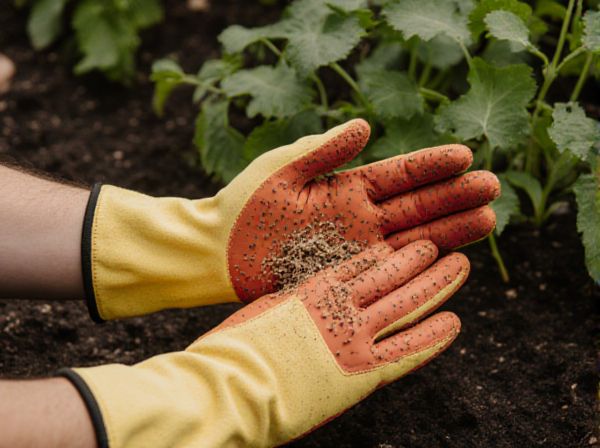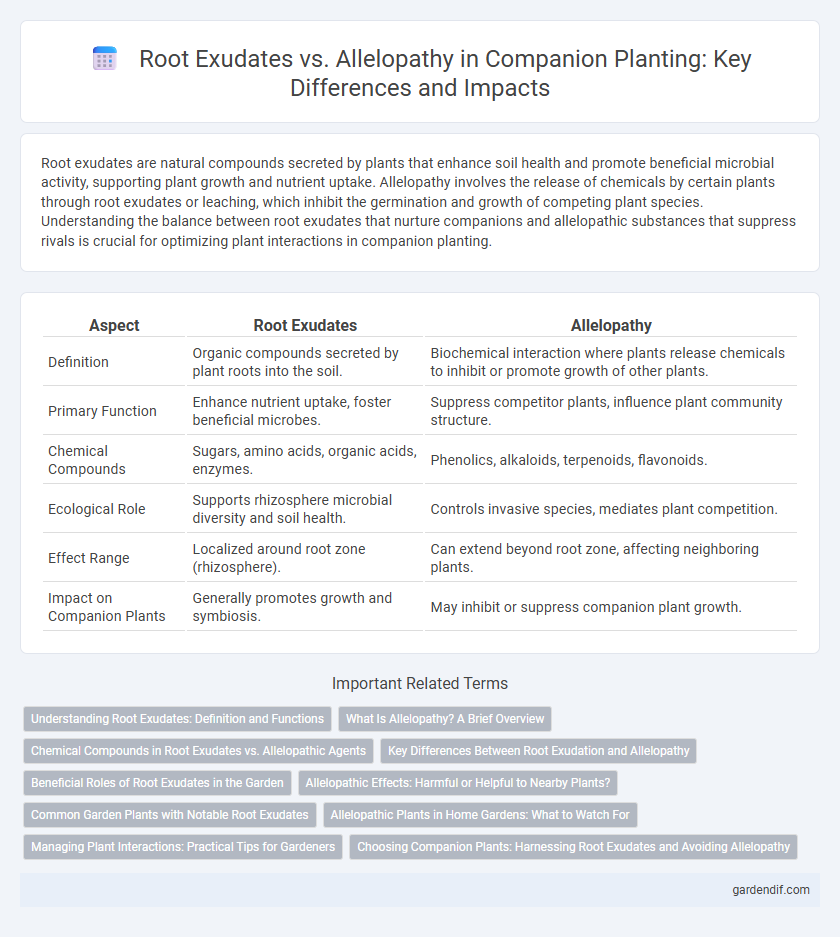
Root exudates vs Allelopathy Illustration
Root exudates are natural compounds secreted by plants that enhance soil health and promote beneficial microbial activity, supporting plant growth and nutrient uptake. Allelopathy involves the release of chemicals by certain plants through root exudates or leaching, which inhibit the germination and growth of competing plant species. Understanding the balance between root exudates that nurture companions and allelopathic substances that suppress rivals is crucial for optimizing plant interactions in companion planting.
Table of Comparison
| Aspect | Root Exudates | Allelopathy |
|---|---|---|
| Definition | Organic compounds secreted by plant roots into the soil. | Biochemical interaction where plants release chemicals to inhibit or promote growth of other plants. |
| Primary Function | Enhance nutrient uptake, foster beneficial microbes. | Suppress competitor plants, influence plant community structure. |
| Chemical Compounds | Sugars, amino acids, organic acids, enzymes. | Phenolics, alkaloids, terpenoids, flavonoids. |
| Ecological Role | Supports rhizosphere microbial diversity and soil health. | Controls invasive species, mediates plant competition. |
| Effect Range | Localized around root zone (rhizosphere). | Can extend beyond root zone, affecting neighboring plants. |
| Impact on Companion Plants | Generally promotes growth and symbiosis. | May inhibit or suppress companion plant growth. |
Understanding Root Exudates: Definition and Functions
Root exudates are a diverse array of organic compounds secreted by plant roots, including sugars, amino acids, and phenolics, that influence soil chemistry and microbial communities. These exudates play a crucial role in nutrient acquisition, pathogen defense, and the establishment of beneficial symbiotic relationships in the rhizosphere. Understanding the specific composition and functions of root exudates helps distinguish them from allelopathic chemicals, which are typically inhibitory substances released to suppress competing plants.
What Is Allelopathy? A Brief Overview
Allelopathy refers to the biological phenomenon where plants release chemicals called allelochemicals through root exudates, leaves, or other tissues that influence the growth, survival, and reproduction of neighboring plants. These natural chemical interactions can suppress weeds, inhibit seed germination, or affect nutrient uptake, playing a crucial role in plant competition and ecosystem dynamics. Understanding allelopathy helps optimize companion planting strategies by selecting species that release beneficial or neutral exudates to improve soil health and crop productivity.
Chemical Compounds in Root Exudates vs. Allelopathic Agents
Root exudates encompass a diverse array of chemical compounds including sugars, amino acids, organic acids, and secondary metabolites that facilitate nutrient exchange and microbial interactions in the rhizosphere. Allelopathic agents, a subset of these compounds, specifically inhibit the growth of competing plant species through phytotoxins such as phenolics, terpenoids, and alkaloids. Understanding the chemical composition of root exudates versus allelopathic agents provides insight into their distinct roles in plant communication and competition within companion planting systems.
Key Differences Between Root Exudation and Allelopathy
Root exudates are organic compounds secreted by plant roots, including sugars, amino acids, and organic acids, which primarily facilitate nutrient uptake, microbial interactions, and soil health. Allelopathy involves the release of biochemical toxins through root exudation that suppress the growth of competing plants, serving as a chemical defense mechanism. The key difference lies in root exudates promoting beneficial soil interactions, whereas allelopathy specifically targets and inhibits neighboring plant species through phytotoxic substances.
Beneficial Roles of Root Exudates in the Garden
Root exudates play a crucial role in the garden by enhancing soil fertility through the secretion of organic acids, sugars, and enzymes that stimulate beneficial microbial activity and nutrient availability. These compounds support symbiotic relationships with nitrogen-fixing bacteria and mycorrhizal fungi, improving plant growth and resistance to pathogens. Unlike allelopathy, which involves the release of chemicals that inhibit neighboring plants, root exudates primarily promote a healthy rhizosphere that fosters plant health and biodiversity.
Allelopathic Effects: Harmful or Helpful to Nearby Plants?
Allelopathic effects involve the release of biochemicals by certain plants that can inhibit or promote the growth of nearby plants, influencing plant competition and ecosystem dynamics. Unlike root exudates, which primarily aid in nutrient uptake and microbial interactions, allelopathic compounds may suppress seed germination, root elongation, or fungal pathogens, acting as natural herbicides. Understanding allelopathy is crucial for companion planting strategies, as selecting compatible species can harness these effects to reduce pests and enhance crop productivity.
Common Garden Plants with Notable Root Exudates
Common garden plants like legumes, sunflowers, and marigolds release root exudates that enhance soil nutrient availability and promote beneficial microbial activity. These exudates differ from allelopathy, where plants such as black walnut and eucalyptus secrete chemicals specifically to inhibit the growth of competing plants. Understanding the distinction between root exudates and allelopathic compounds aids in selecting companion plants that improve garden health and productivity.
Allelopathic Plants in Home Gardens: What to Watch For
Allelopathic plants release biochemicals through root exudates that inhibit the growth of neighboring plants, which can significantly impact home garden biodiversity. Common allelopathic species like black walnut, eucalyptus, and tree of heaven produce potent compounds that suppress seed germination and root development in companion plants. Gardeners should monitor these plants closely to prevent unwanted interference with vegetable crops, herbs, and ornamental plants, ensuring a balanced ecosystem and optimal growth conditions.
Managing Plant Interactions: Practical Tips for Gardeners
Root exudates release organic compounds into the soil that enhance beneficial microbial activity and nutrient availability, promoting plant growth without harming neighbors. Allelopathy involves chemical inhibition where certain plants secrete substances that suppress or stunt the growth of competing species, which can be strategically managed to control weeds naturally. Gardeners can optimize plant interactions by selecting compatible species with complementary root exudate profiles and using allelopathic plants as natural mulch or barriers to reduce unwanted vegetation.
Choosing Companion Plants: Harnessing Root Exudates and Avoiding Allelopathy
Choosing companion plants requires understanding root exudates, the chemical compounds released by roots that promote beneficial microbial activity and nutrient uptake. Avoid plants known for allelopathy, as their root exudates can inhibit growth or germination of neighboring species, reducing overall garden productivity. Selecting compatible companions based on root chemistry enhances soil health and maximizes plant synergy for improved growth and resilience.
Root exudates vs Allelopathy Infographic

 gardendif.com
gardendif.com